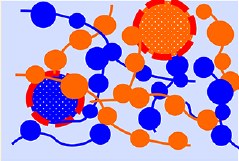Souha Ben Mahmoud, Wafa Essafi, Annie Brûlet and François Boué
The chain conformation in sulfonated polystyrene PSSNa of a degree of sulfonation 0.34 ≤ f ≤ 1, i.e., of various hydrophobicity, is followed in mixtures of water and increasing content of tetrahydrofuran (THF), a good solvent of the hydrophobic polystyrene moieties (which improves the solvent quality of the mixture). This is achieved by measuring the chain form factor by small-angle neutron scattering using the zero average contrast method (ZAC). Polymer concentrations 0.17 and 0.34 M correspond in our case to the semidilute regime or its limit with dilute regime depending on the chain conformation. The main result is the monitoring with added THF of the pearl necklace conformation. This heterogeneous structure, made of wormlike chain parts (strings) and pearls, was observed formerly in water: when f decreases, the string contribution decreases, and the pearls size, characterized by a maximum in Kratky q2S1(q) representation, slightly increases. Here we see that in the presence of increasing content of added THF (i) the pearls contribution decreases, as expected, and (ii) their size does not change by more than 10% in most cases (30% at the most). Among different modeling, the most complete has been done following the pearl necklace models of Schweins, Huber et al. and Lages, Huber et al.; beyond the size and distribution of pearls, it addresses the radius of gyration, the correlation distance between spheres, weakly visible, and, importantly their number N. The values of Rg, as well as the modeling, suggest that while the sphere size varies a few, N decreases clearly with added good solvent. A link with the simulation of Liao et al. can be found. A second result, important in practice, is that all modeling of the scattering establishes that THF addition makes vanish an excess of low q scattering due to large compact spheres present in water. A third result is obtained after a “THF treatment” procedure, consisting of adding THF and then removing it by evaporation: (i) the spherical aggregates are washed out, and (ii) the pearl necklace conformation of the chain returns to the one in water solution before treatment. Therefore, the pearl necklace conformation of the hydrophobic polyelectrolyte in aqueous solution appears to be in an annealed equilibrium state resulting from hydrophobic attraction and electrostatic repulsion.
nttps://doi.org/10.1021/acs.macromol.8b00990




